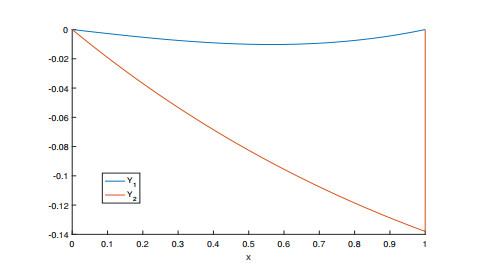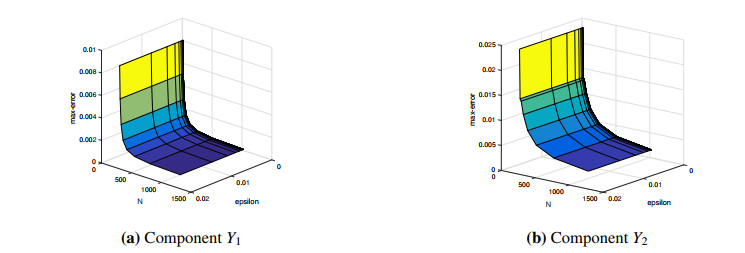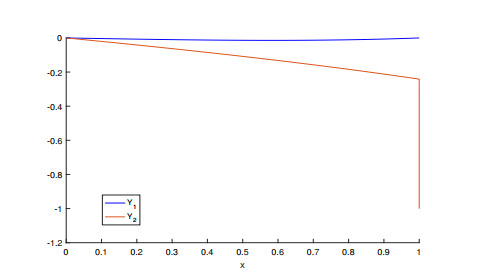1.
Introduction
A singularly perturbed problem (SPP) is a differential equation, for which the solution is affected by a small parameter that multiplies the leading derivative term. The solutions to these problems undergo fast changes in small portions of the domain, hence the traditional numerical approaches are ineffective for SPP. For these types of situations, it is required to develop suitable numerical approaches such that the error estimates are independent of the parameter. A technique that provides parameter-uniform numerical solutions is found in [6,19]. In such cases, the most effective and simplest approach is the Shiskin mesh (piecewise uniform mesh).
Nonlocal boundary value issues are differential equations having conditions that link the values of the unknown solution at the boundary with values inside the equation. Of these, the differential equation with IBC is the essential problem that has been researched so far. A few years ago, research was carried out by the authors of [4,7,8,12,16,17,28,32] to analyze the behavior of solutions to the higher-order differential equations with IBC that are not singularly perturbed. This article concentrates on singularly perturbed fourth-order convection diffusion differential equations with IBC.
Later, Debela and Duressa suggested a computational method for the class of SPCDE with IBC using the fitted operator method and the Richardson extrapolation technique in [3]. A singularly perturbed linear system of the Fredholm integro-differential problem with IBC is considered in [5]. They investigated a second-order convergent by applying the finite difference approach using the trapezoidal rule in both the equation and the initial condition. In [14], a uniform first-order solution is obtained by imposing a Bakhvalov mesh for the first order parameterized singularly perturbed differential equation with IBC, whereas the authors of [15] prove a second order convergent. Raja and Tamilselvan [22] discussed the finite difference scheme on Shishkin mesh for a system of singularly perturbed convection diffusion equations with IBC.
The numerical method for the fourth-order SPP is considered in [9,23,27]. A quintic B-spline approach for solving the fourth-order singularly perturbed boundary value problem provides a solution without reducing the order. An initial value technique for the fourth-order singularly perturbed boundary value problems was examined by Mishra in [20]. Research articles [18,21,24,25,26] deal with third-order convection differential equations. Zen et al. [2] presented a numerical technique to solve a nonlinear SPP with IBC. The authors of [11] discussed SPP with boundary turning points. The numerical methods for higher-order differential equations, fractional integro-differential equations, and biharmonic problems are discussed in [1,10,13,29,30,31].
The organisation of this article is as follows: Section 2 defines the problem's statement, as supported to Section 3, which establishes the maximum principle, the stability finding, and the estimations of the analytical solutions that were produced. The numerical scheme is provided in Section 4, while Section 5 yields the error estimates for each numerical solution and Section 6 offers the numerical experiments. The research article is concluded with a discussion given in Section 7.
2.
Problem description
Inspired by [7,20,27] works, we take into account the ensuing fourth order SPCDE with IBC:
where 0<ε<<1, a(t)≥α1>α+2>3, b(t)≥β≥0, θ≤c(t)≤θ0≤0, β+2θ>0, g(t) is non negative with 1∫0g(t)dt<1, a(t),b(t),c(t),f(t),g(t) are sufficiently smooth on [0,1]=ˉΩ and y∈C4(Ω)∩C2(ˉΩ).
Through out the paper, we assume that ε≤CN−1 and ‖y‖D=supx∈D|y(x)|. C is independent constant of ε.
3.
Analytical results
The Eqs (2.1)–(2.3) may be changed into the following problem:
where ˉy(t)=(y1(t),y2(t)) with the boundary conditions
Theorem 3.1. (Maximum Principle) Let ˉy(t) be any function satisfying y1(0)≥0,y1(1)≥0, y2(0)≥0,By2(1)≥0, L1ˉy(t)≥0 and L2ˉy(t)≥0,t∈Ω. Then ˉy(t)≥0, t∈¯Ω.
Proof. Define ˉs(t)=(s1(t),s2(t))ass1(t)=2(1−t22),s2(t)=1. Note that ˉs(t)>0,t∈¯Ω, ˉL1ˉs(t)>0,L2ˉs(t)>0t∈Ω, s1(0)>0,s2(0)>0,s1(1)>0 and Bs2(1)>0. Further we define
Then there exists at least one t0∈Ω, such that (−y1(t0)s1(t0))=γ or (−y2(t0)s2(t0))=γ or both. Also (ˉy+γˉs)(t)≥ˉ0,t∈ˉΩ. Without loss of generality we assume that (−y1(t0)s1(t0))=γ. Then (y1+γs1) attains its minimum at t=t0. It is simple to see that for every t∈¯Ω, ˉy(t)≥0 if γ≤0. Now we will show that indeed γ≤0. Suppose γ>0.
Case (ⅰ): If (y1+γs1)(t0)=0, for t0=0, Then,
Case (ⅱ): If (y1+γs1)(t0)=0, for t0∈Ω, Then,
Case (ⅲ): If (y1+γs1)(1)=0, Then,
Case (ⅳ): If (y2+γs2)(1)=0, Then,
Case (ⅴ): If (y2+γs2)(t0)=0, for t0∈Ω. Therefore (y2+γs2) attains its minimum at t=t0. Then,
Case (ⅵ): Assume that (y2+γs2)(1)=0, Then,
Be aware that we reached a contradiction in each and every situation. Therefore, γ>0 cannot exist. This demonstrates that y1(t)≥0, y2(t)≥0. Hence ˉy(t)≥0,t∈ˉΩ. □
Lemma 3.2. (Stability Result) The solution to the problem (3.1)–(3.4) is ˉy(t), fulfils the condition.
Proof. Define ψ±i(t)=CMsi(t)±ui(t),t∈¯Ω,i=1,2, where
Note that ψ±1(0)≥0, ψ±1(1)≥0, ψ±2(0)≥0 and Bψ±2(1)≥0. Observe that L1ˉψ±(t)≥0, L2ˉψ±(t)≥0. The desired outcome is then obtained using the maximal principle. □
The following lemma gives bounds for the derivatives of ˉy(t).
Lemma 3.3. Let (2.1) and (2.2) be the solution, and let ˉy(t) be the solution. Then, for 1≤k≤3,
Proof. This lemma may be demonstrated by applying the arguments provided in [6] and corollary 3.2 in that order. □
The sharper constraints on the derivatives of the solution ˉy(t) may be used to calculate the uniform error estimate. We formulate the analytical solution in the form ˉy(t)=ˉv(t)+ˉw(t) to get sharper constraints, where ˉv(t)=(v1(t),v2(t)) and ˉw(t)=(w1(t),w2(t)). The regular component ˉv(t) can be written as ˉv(t)=ˉv0(t)+εˉv1(t)+ε2ˉv2(t), where ˉv0(t)=(v01(t),v02(t)), ˉv1(t)=(v11(t),v12(t)), ˉv2(t)=(v21(t),v22(t)) respectively satisfy the following equations:
Consequently, the regular component ˉv(t) is the solution to
and layer component ˉw(t) is the solution of
Theorem 3.4. Let ˉv0(t) be the solution to the reduced problem ˉv0(t) and ˉy(t) be the solution to the problem (2.1) and (2.2). Then
Proof. Consider ˉψ±(t)=(ψ±1(t),ψ±2(t)), where
Note that ψ±1(0)≥0, ψ±1(1)≥0, ψ±2(0)≥0 Further
Let t∈(0,1). Then
The maximal principle then gives us ˉψ±(x)≥0,t∈¯Ω. □
Lemma 3.5. The solution ˉy(t) to the problem (3.1)–(3.4) satisfies the following constraints in its regular and singular components, respectively:
Proof. With the method described in [6], the necessary limits on ˉv, ˉw, and their derivatives are obtained. □
Note: It is simple to observe from the aforementioned theorem that,
4.
Discretization problems
On ˉΩ, a piecewise uniform Shishkin mesh with mesh intervals of N (≥4) is produced. Two subintervals are created for the domain ˉΩ: [0,1−σ] and [1−σ,1] where σ is the transitional parameter and σ=min{12,2εlnNα} specifies it. With regard to [0,1−σ] and [1−σ,1]. A homogeneous mesh with N2 mesh spacing is put in place. The interior mesh points are shown by
Clearly, ˉΩN={ti}N0.The mesh step should be hi=ti−ti−1, and the bar step should be ℏi=hi+1+hi2.
The discrete problem that results from (2.1) and (2.2) is:
Find ˉY=(Y1(ti),Y2(ti)) such that
where
Theorem 4.1. (Discrete maximum principle) Let ˉΨ(ti)=(Ψ1(ti),Ψ2(ti)) be the mesh function satisfying Ψ1(t0)≥0,Ψ2(t0)≥0,Ψ1(tN)≥0,BNΨ2(tN)≥0,LN1ˉΨ(ti)≥0, and LN2ˉΨ(ti)≥0. Then ˉΨ(ti)≥0, ti∈¯ΩN.
Proof. Let ˉS(ti)=(S1(ti),S2(ti)) where
S1(ti)=2(1−t2i2),ti∈¯ΩN,
S2(ti)=1,ti∈¯ΩN.
Note that ˉS(ti)>0,∀ti∈¯ΩN, S1(t0)>0,S1(tN)>0,S2(t0)>0,BNS2(tN)>0,LN1ˉS1(ti)>0 and LN1ˉS1(ti)>0, ∀ti∈ΩN. Let
Then there exists one tk∈¯ΩN such that Ψ1(tk)+γS1(tk)=0 or Ψ2(tk)+γS2(tk)=0 or both. We have Ψj(ti)+γSj(ti)≥0,ti∈¯ΩN,j=1,2. Therefore either (Ψ1+γS1) or (Ψ1+γS1) attains minimum at ti=tk. Suppose the theorem does not hold true, then γ>0.
Case (ⅰ): If (Ψ1+γS1)(t0)=0, Then,
Case (ⅱ): If (Ψ1+γS1)(tk)=0, for tk∈ΩN. Then,
Case (ⅲ): If (Ψ1+γS1)(tN)=0, Then,
Case (ⅳ): If (Ψ2+γS2)(t0)=0, Then,
Case (ⅴ): If (Ψ2+γS2)(tk)=0, for tk∈ΩN. Then,
Case (ⅵ): If (Ψ2+γS2)(tN)=0, Then,
Note that we got to a contradiction in each and every situation. In light of this, γ>0 cannot exist. According to this, Ψ1(ti)≥0, Ψ2(ti)≥0. Hence ˉΨ(ti)≥0,ti∈¯ΩN. □
Lemma 4.2. (Discrete stability result) Let ˉY(ti)=(Y1(ti),Y2(ti)) be any mesh function. Then
Proof. One may prove the aforementioned inequality by utilising Theorem 4.1, and proper barrier functions. □
Similar to the continuous case, the discrete solution ˉU(xi) may be broken down into ˉY(ti)=ˉV(ti)+ˉW(ti), where V(ti) and W(ti) are the answers to the following problems, respectively:
and
The theory that follows provides an estimation for the difference between the answers of (4.1)–(4.3).
Theorem 4.3. Let ˉY be the numerical solution to the equation (2.1) and (2.2) as specified by (4.1) and (4.2). A numerical solution of (3.8) defined by (4.3) and ˉV. Then
Proof. Consider ˉΨ±(ti)=(Ψ±1(ti),Ψ±2(ti)), where
Now
Then we arrive at the conclusion using Theorem 4.1. □
5.
Estimated errors for the solution
For each component of the numerical solution, we get a different estimate of the error.
Lemma 5.1. Assume that ˉV(ti) is a numerical solution to the Eq (3.8) as specified by (4.3). Then
Proof. Now
Therefore
Further
where ti−1≤χi≤ti, 1≤i≤N. Then, as a result of discrete stability, we have |(vj(ti)−Vj(ti))|≤CN−1,ti∈ˉΩN,j=1,2. □
Lemma 5.2. Let (3.9) defined in (3.9) have a numerical solution, ˉW(ti). Then
Proof. Observe that
Then by (3.14), Theorem 3.4 and Lemma 5.1, we have
Therefore
Consider ˉΨ±(ti)=(Ψ±1(ti),Ψ±2(ti)),ti∈[1−σ,1], where
In consideration of the discrete maximum concept, we therefore have Ψ±j(ti)≥0, ti∈[1−σ,1],j=1,2.
Therefore |wj(ti)−Wj(ti)|≤CN−1(lnN)2,ti∈[1−σ,1],j=1,2. □
Theorem 5.3. Let (2.1) and (2.2) be the solution as defined in (4.1) and (4.2), and let ˉY(ti) be the result. Then
Proof. The proof is finished by combining the Lemmas 5.1 and 5.2. □
6.
Numerical results
Example 6.1.
Example 6.2.
There is no analytical answer for the aforementioned situations. As a result, we use the double mesh principle, which is defined as DNε=maxxi∈¯ΩNε|UN(xi)−U2N(xi)| and DN=maxεDNε, where the numerical solution calculated using N and 2N mesh points is denoted by UN(xi) and U2N(xi). The order of convergence is given by PN=log2(DND2N) based on these values.
For different values of ε, the approximate solutions for Example 6.1 are plotted in Figure 1 on a Shishkin mesh. Numerical solutions of Example 6.1 are plotted in Figure 2. These figures show that when ε decreases, boundary layers are present near x=1. The most possible pointwise error in the numerical solution is plotted in Figures 3 and 4 for Examples 6.1 and 6.2.
7.
Conclusions
This article has provided the fitted mesh method for the fourth-order SPCDE with IBC. As a consequence, the approach converges in the discrete maximum norm with ε-uniformity with respect to the perturbation parameter. Maximum absolute errors and convergence rates have been reported for the given numerical results (see Tables 1–4). According to these observations, the proposed method is uniformly convergent and has almost first-order accuracy on the piecewise uniform mesh. Concisely, the strategy is reliable and well-suited for dealing with such problems. Further, higher-order difference schemes can be proposed to promote numerical investigations.
Conflict of interest
The author declares that there is no conflict of interest regarding the publication of this paper.










 DownLoad:
DownLoad:






